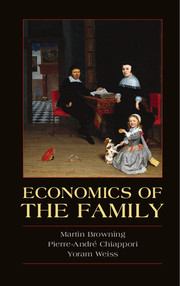Book contents
- Frontmatter
- Contents
- List of Tables
- List of Figures
- Acknowledgments
- Introduction
- PART I MODELS OF HOUSEHOLD BEHAVIOR
- 1 Facts
- 2 The Gains from Marriage
- 3 Preferences and Decision Making
- 4 The Collective Model: A Formal Analysis
- 5 Empirical Issues for the Collective Model
- 6 Uncertainty and Dynamics in the Collective Model
- PART II EQUILIBRIUM MODELS OF THE MARRIAGE MARKET
- Author Index
- Subject Index
1 - Facts
Published online by Cambridge University Press: 05 July 2014
- Frontmatter
- Contents
- List of Tables
- List of Figures
- Acknowledgments
- Introduction
- PART I MODELS OF HOUSEHOLD BEHAVIOR
- 1 Facts
- 2 The Gains from Marriage
- 3 Preferences and Decision Making
- 4 The Collective Model: A Formal Analysis
- 5 Empirical Issues for the Collective Model
- 6 Uncertainty and Dynamics in the Collective Model
- PART II EQUILIBRIUM MODELS OF THE MARRIAGE MARKET
- Author Index
- Subject Index
Summary
The purpose of this chapter is to present some basic and general facts about marriage and the family. The chapter is intended to motivate the analysis that follows in the rest of the book by showing how presumably noneconomic activities, such as marriage and fertility, interact with economic considerations such as work, wages, and schooling.
Marriage, Divorce, and Remarriage
Marital Status
Marriage is a “natural state.” Table 1.1 shows the proportions (the “stocks”) in each marital state for three different years for six high-income countries. These figures show that most of the adult population (aged 20 or older) is married at any given time (about 55 to 70 percent). However, the proportion of the adult population that is married has declined in all six countries over the last fifty years. This trend is accompanied by a larger proportion of never-married and a higher proportion of divorced individuals, with little change in the proportion of widowed (because of the offsetting effects of reduced marriage and mortality). In all countries and at all times, the proportion of never-married women is significantly lower than the proportion of never-married men; this is partially attributable to the fact that men marry later.
Explaining these cross-country regularities and trends is a major challenge for demographers and economists. Factors that may be related to the changes in marital status that we see in this table are changes in the age structure, delays in marriage, the relative attractiveness of alternative household arrangements, higher turnover, and longer life spans.
- Type
- Chapter
- Information
- Economics of the Family , pp. 11 - 57Publisher: Cambridge University PressPrint publication year: 2014
- 13
- Cited by

